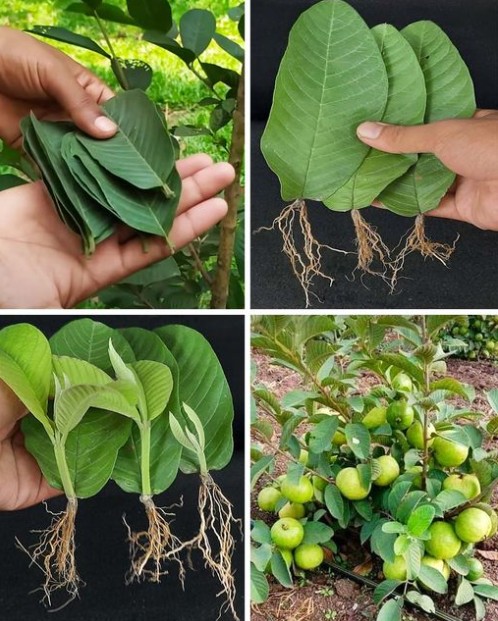Materials You Will Need:
Healthy guava leaves from a mature guava tree
A clean, sharp knife or scissors
Rooting hormone (optional)
A pot with well-draining soil or a seedling tray
Plastic bags or plastic wrap
A warm and bright location with indirect sunlight
Step-by-Step Guide:

1. Leaf Selection:
Begin by selecting healthy and mature guava leaves from a healthy guava tree. It’s essential to choose leaves that are free from pests and diseases, as these can affect the success of leaf propagation.
2. Leaf Cuttings:
Using a clean, sharp knife or scissors, cut the guava leaves into sections, making sure that each section includes a portion of the main vein. Each cutting should be about 4-6 inches in length. If you have access to multiple healthy leaves, consider taking several cuttings to increase your chances of success.
3. Rooting Hormone (Optional):
While not mandatory, using a rooting hormone can enhance the chances of successful root development. If you decide to use a rooting hormone, dip the cut end of each leaf cutting into the hormone following the manufacturer’s instructions.
4. Planting:
Plant the prepared leaf cuttings in a pot with well-draining potting mix or soil. You can plant them horizontally with the cut end partially buried in the soil. Plant multiple cuttings in the same pot or tray, spacing them a few inches apart.
5. Enclose in Plastic:
Cover the pot or seedling tray with a clear plastic bag or plastic wrap to create a mini greenhouse effect. This will help maintain humidity around the leaf cuttings, which can aid in rooting.
6. Provide Adequate Care:
Place the pot or tray in a warm location with bright, indirect sunlight. Maintain consistent moisture in the soil by lightly misting the cuttings or watering them as needed. The soil should be kept consistently moist but not waterlogged.
7. Patience:
Root development can take time, ranging from several weeks to several months. Be patient and continue to care for the cuttings during this period. Keep an eye on the humidity level inside the plastic enclosure, as it should remain relatively high.
8. Transplanting:
Once the leaf cuttings have developed a healthy root system and have grown into small plants, they can be transplanted into larger pots or directly into your garden. Ensure they receive adequate sunlight and water as they continue to grow.
Tips and Considerations:
Not all guava leaves will successfully root and grow into new trees using this method. The success rate can vary.
Some guava varieties may be more suitable for leaf propagation than others. Experimentation may be necessary to determine the best results.
Be careful not to overwater the leaf cuttings, as excessive moisture can lead to rot.
Maintain a warm and humid environment for the leaf cuttings during the rooting phase to encourage successful propagation.

